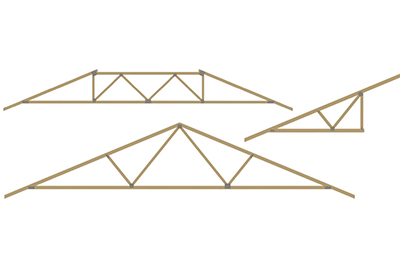The roof is a crucial element of any home, and residential roof trusses play a vital role in its structure and stability. Building Your Dream Home? Understanding Residential Roof Trusses delves into the world of trusses, explaining their function, benefits, and different types to empower you to make informed decisions for your dream home.
Beyond Simple Rafters: The Role of Residential Roof Trusses
Gone are the days of relying solely on traditional rafters for roof support. Residential roof trusses are prefabricated assemblies of lumber connected with metal plates, forming a strong and lightweight framework. Building Your Dream Home? Understanding Residential Roof Trusses highlights the key benefits of using trusses:
- Strength and Stability: Trusses are incredibly strong and can span larger distances compared to traditional rafters, offering superior support for your roof.
- Design Flexibility: Trusses come in various shapes and sizes, allowing for creative roof designs, vaulted ceilings, and cathedral ceilings.
- Lightweight Construction: Trusses are lighter than traditional rafters, reducing stress on your home's walls and foundation.
- Faster Installation: Prefabricated trusses arrive ready to be installed, streamlining the construction process and saving time on your project.
- Cost-Effectiveness: While the initial cost per unit might be slightly higher than traditional rafters, trusses can be more cost-effective due to faster installation and reduced material waste.
A World of Options: Exploring Different Types of Residential Roof Trusses
Building Your Dream Home? Understanding Residential Roof Trusses showcases the variety of truss options available:
- Truss Roof Styles: Choose from common styles like gable trusses (for standard peaked roofs), hip trusses (for pyramidal roofs), or truss variations for vaulted or cathedral ceilings.
- Top Chord Styles: King post trusses feature a central post for additional support, while queen post trusses utilize two posts for wider spans.
- Material Options: Engineered wood products like lumber veneers laminated (LVL) are commonly used for trusses, offering strength and dimensional stability.
Choosing the Right Residential Roof Trusses for Your Project:
Building Your Dream Home? Understanding Residential Roof Trusses recognizes the importance of selecting the appropriate trusses:
- Consult with an Architect or Engineer: These professionals can help determine the right type and size of trusses based on your roof design, span requirements, and local building codes.
- Consider Your Roof Design: The chosen truss style should complement your desired roof style and any architectural features.
- Structural Requirements: Span, load-bearing capacity, and wind resistance are crucial factors to consider when choosing trusses.
- Quality and Certification: Ensure the trusses are manufactured by a reputable company and meet relevant building code standards.
Building Your Dream Home with Confidence
Building Your Dream Home? Understanding Residential Roof Trusses equips you with the knowledge to make informed decisions about this crucial building component. By understanding the benefits and types of residential roof trusses, you can work with your architect, engineer, and builder to choose the right option for your dream home, ensuring a strong, beautiful, and long-lasting roof over your head.
| For More: |
| Contact: 393096889 |
| Email: info@thetrusspeople.com.au |
| Timings: Mon-Fri:9AM–5PM |
| Visit Us: https://thetrusspeople.com.au/ |





